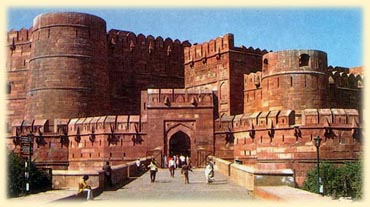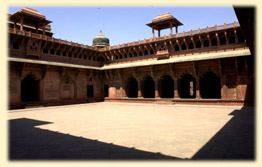Agra Fort - Agra
|
|
Akbar, the grandson of Babar built his capital at Agra and laid the foundation of the Agra Fort. He began construction of this majestic fort in 1565 when he was only 23 years old. This imposing red sandstone structure is the finest example of craftsmanship of the Mughal era. After Taj this was one of the most important group of buildings. The construction was started in 1565 and was completed in about eight years at a cost of thirty five lakh of rupees under the superintendence of Qasim Khan Mir Barr-u-Bahr. This fort was built on the banks of the river
Yamuna. |
 |
|
This fort was just one of the many large fortified residences that the emperor wanted to have at various strategic points of his empire. According to Abul
Fazal, the fort contained over five hundred buildings. But later on Akbar's descendants added new buildings, mainly in marble to the fort and demolished the old ones. |
|
 |
Architecture of the Agra Fort
Agra fort is built in a triangular form and covers an overall area of about 1.5 miles punctuated by gracefully carved bastions at regular intervals. Of the four gates, the Amar Singh Gate to the south is the only one gate which is open to the visitors. It is beautified by glazed tiles. Within the walls of the Agra Fort, Jahangir built rose-red palaces, courts and gardens, and Shah Jahan embellished it with marble mosques, palaces and pavilions of gem-inlaid white marble. The Jahangir Mahal with its fretwork is the largest private residency within the fort. This Mahal has a complex arrangement of compartments which later became the residence of Jahangir. To the south of Jahangir Mahal are the ruins of the Akbari Mahal, guilded by a pillared hall.
|
|
Later some other buildings were added by Shah Jahan to the Agra Fort. These buildings are the Moti Masjid (pearl mosque) and the Diwan-e-Aam (hall of public audience) from where a passage and steps lead to Macchi Bhawan (the royal aquarium). In the centre of the courtyard is the grave of John Russel Colvin, Lt. Governor of the North Western Provinces who died during the 1857 uprising. The Nagina Mosque (mosque of gems) lies to the left of the throne room. Beneath this existed the Meena
Bazar, from where the ladies of the house watch the merchants who display their silks, brocades and jewellery in the courtyard below. At the Chittor Gates, trophies of Akbar's captures of a Rajput fortress in 1657 are displayed. Towards the riverside is the Diwan-e-Khas (hall of private audience), built by Shah Jahan in 1637.
|
|
|
On the terrace beyond, are two thrones in white marble and black slate. From here the prince Jehangir used to watch the elephant fights on the plains below. From here a staircase leads to the Musamman Burj (Jasmine tower). It has a beautiful courtyard paved with squares of black marble on one side. It is believed that this octagonal tower had a large bell that hung from the bastions to the ground. This bell was rung by those who came to seek justice. Shah Jahan wanted to build a replica of the white Taj in black marble as well and connect them through a bridge across the waters of Yamuna. Before he could do so he fell ill and was soon imprisoned in the Agra Fort by his son Aurangzeb along with his daughter Jahan Ara, where he finally breathed his last. It was from here that the Emperor Shah Jahan spent his last days in imprisonment, gazing at the tomb of his wife. |
 |
|
|
Probably the smallest mosque for private prayer, Mina Masjid lies just ahead. Some other such monuments are the Khas
Mahal, the Golden pavilions, Anguri Bagh (grape garden), Sheesh Mahal (palace of mirrors) and the legendary Gates of
Somnath, believed to have been carried away by Mahmud Ghazni in 1025. Also the famous Jami Masjid built by Shah Jahan for his beloved daughter, Jahan Ara lies here. |
|
|
|
|
|